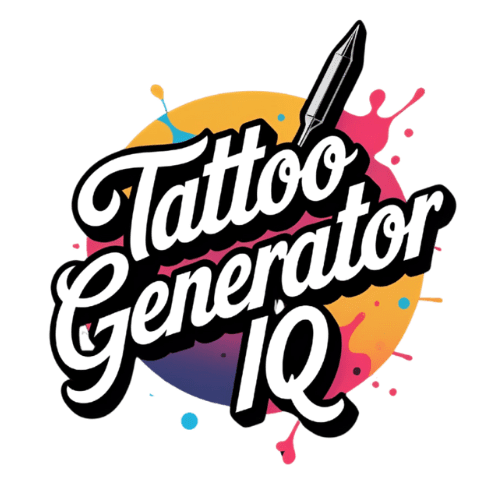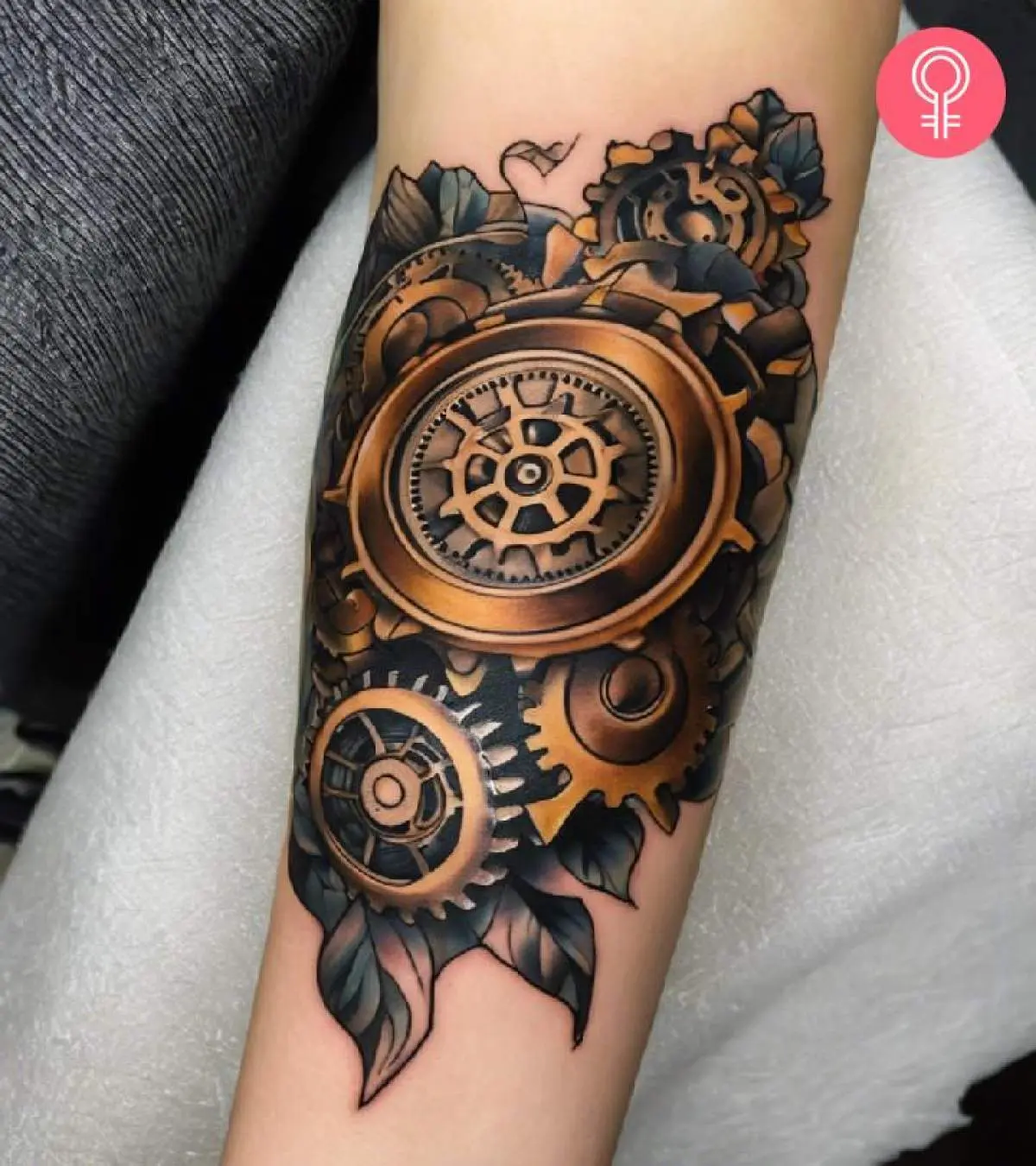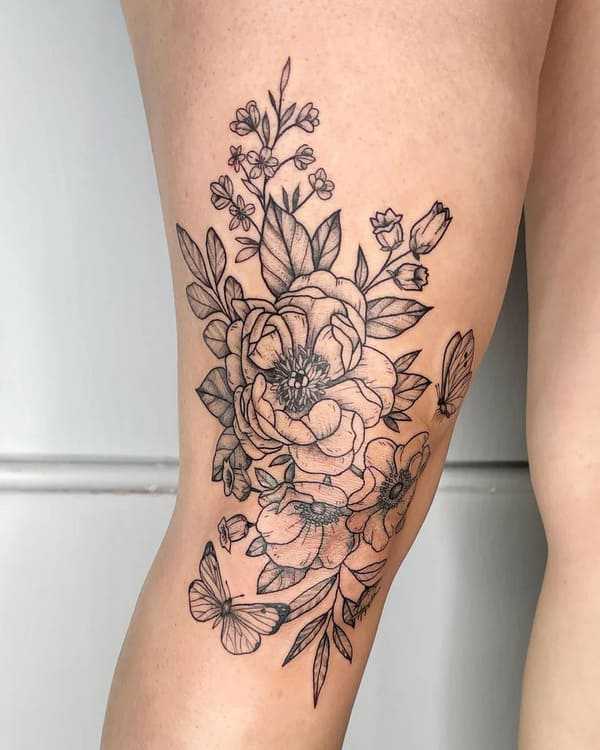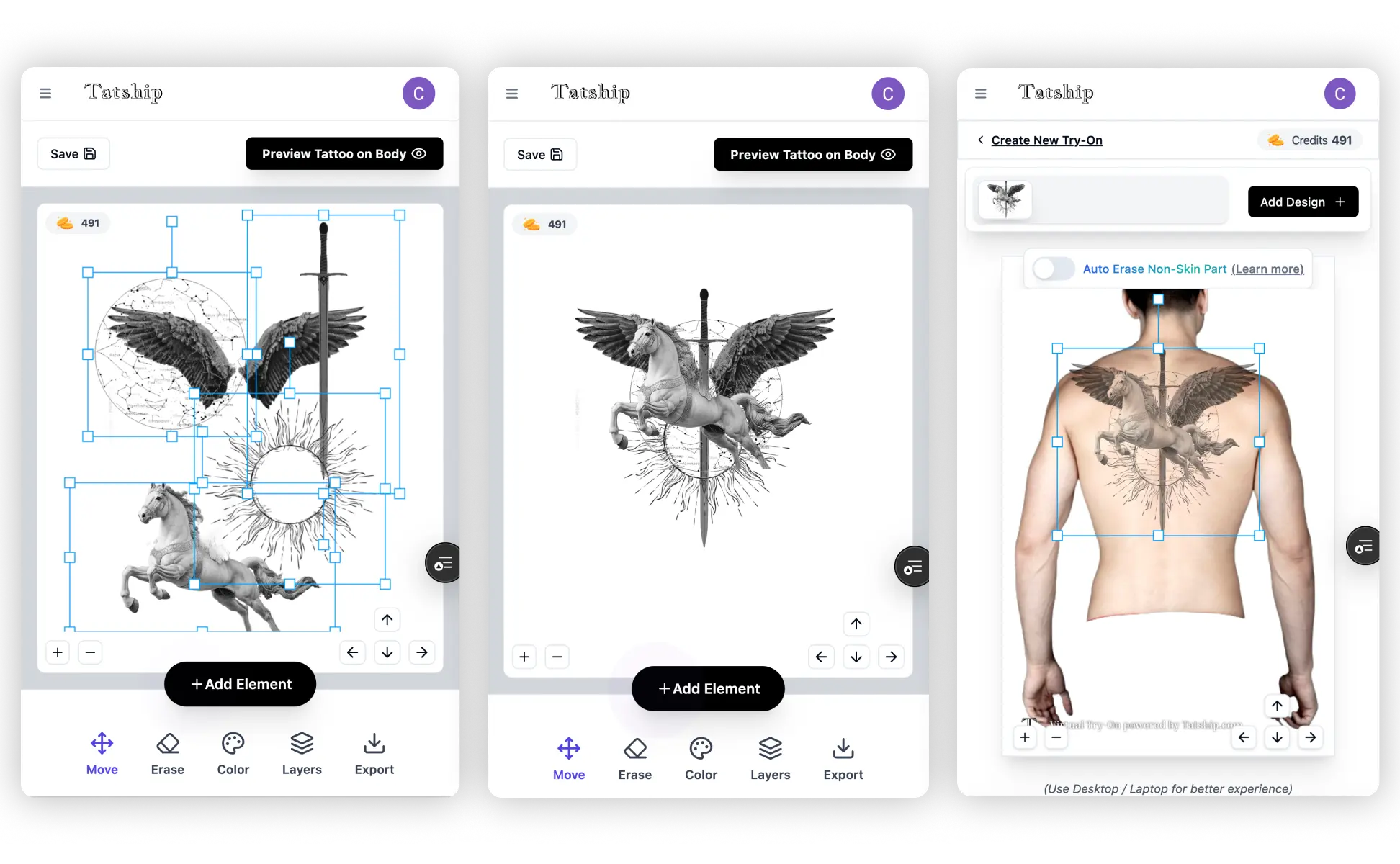25 Badass Knee Tattoo Ideas That’ll Make You Want to Show Off Your Legs
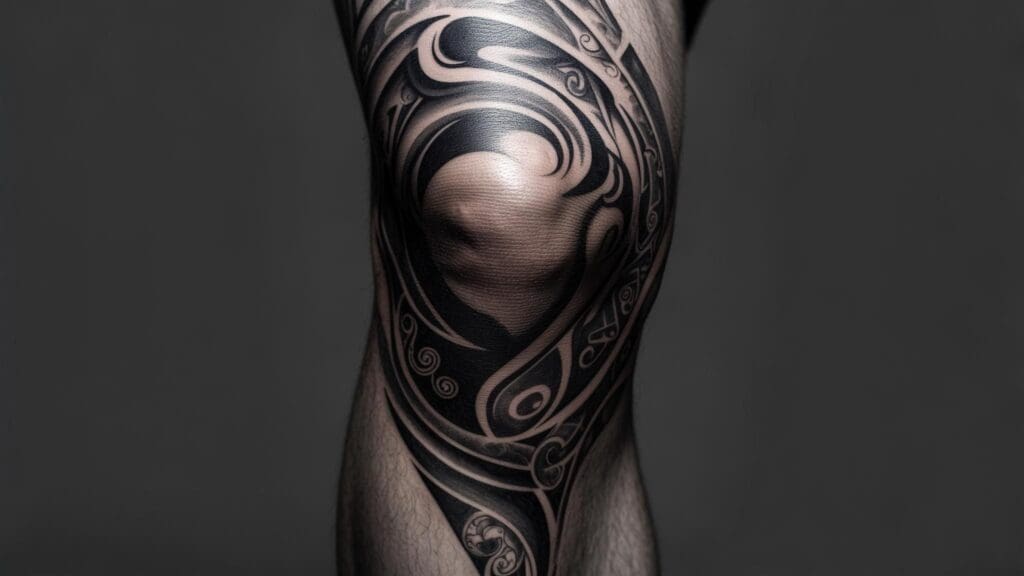
According to Tattoodo, knee tattoos possess “something that’s visually strong and sexy about knee cap tattoos that balance the intensity of the placement and the artistry in it” (source). I remember the first time I saw someone with a stunning mandala knee tattoo at the gym – the way it moved with their leg during squats was mesmerizing, and I couldn’t stop thinking about how bold they were to choose such a challenging placement.
Source: tiktok.com
Knee tattoos aren’t for everyone, and that’s exactly what makes them so badass. The circular space of your kneecap creates unique opportunities for designs that simply wouldn’t work anywhere else on your body. Whether you’re planning your first knee piece or adding to an existing leg sleeve, choosing the right design requires understanding both the artistic possibilities and practical challenges of this distinctive placement.
You’ll discover 25 incredible knee tattoo ideas across five distinct categories, plus everything you need to know about pain levels, healing considerations, and design adaptability. From traditional roses to futuristic mechanical gears, these concepts will help you find the perfect design that matches your style and pain tolerance.
Table of Contents
- Essential Considerations Before Getting Your Knee Tattoo
- Traditional and Classic Knee Tattoo Designs
- Geometric and Modern Pattern Ideas
- Nature and Organic Design Concepts
- Cultural and Symbolic Tattoo Options
- Unique and Creative Knee Tattoo Concepts
- Planning Your Perfect Knee Tattoo Design
- Final Thoughts
TL;DR
- Knee tattoos are among the most painful placements due to thin skin, bone proximity, and nerve concentration
- Circular kneecap shape works best with mandala, geometric, and radial designs
- Bold, simple designs age better than intricate details due to constant skin movement
- Healing takes 3-4 weeks longer than other body parts because of friction and movement
- Traditional designs offer the most reliable outcomes for first-time knee tattoo recipients
- Professional artist consultation is essential due to the complexity of knee anatomy
- Design placement options include kneecap center, above knee, below knee, or side positioning
Essential Considerations Before Getting Your Knee Tattoo
Understanding the unique challenges of knee tattoos is crucial before committing to this bold placement. Pain levels are significantly higher than most body parts, healing time extends beyond typical expectations, and design choices must accommodate constant movement and skin stretching. Your knee’s anatomy creates specific requirements for successful tattoo application and long-term satisfaction.
Pain intensity reaches extreme levels due to thin skin coverage over bone, concentrated nerve endings, and the kneecap’s sensitivity to vibration during tattooing. The anatomical structure of your knee creates a perfect storm of discomfort factors that even experienced tattoo enthusiasts find challenging.
Healing complications arise from constant leg movement, clothing friction, and the knee’s tendency to swell, requiring extended aftercare periods of 3-4 weeks minimum. Your knee moves constantly throughout the day, preventing the skin from settling into recovery mode properly.
Understanding Pain and Healing Realities
Your pain tolerance will be tested with knee tattoos. The thin skin stretched over bone creates intense sensations that many describe as excruciating. Nerve endings concentrate heavily around the kneecap, making every needle pass feel amplified. Understanding pain levels is crucial, so reviewing the ultimate tattoo pain scale for women can help you prepare mentally for the intensity of knee tattoo sessions.
Anatomical challenges include bone proximity creating vibration amplification, minimal fat padding for cushioning, and high nerve density causing intense pain sensations. Your kneecap sits directly under the skin with virtually no muscle or fat to absorb the tattoo machine’s vibrations.
Extended healing protocols require movement restriction, specialized clothing choices, and vigilant infection prevention due to the knee’s exposure to environmental contaminants. You’ll need to adjust your daily routine significantly during the healing process.
| Body Part | Pain Level (1-10) | Healing Time | Movement Impact |
|---|---|---|---|
| Knee Cap | 9-10 | 3-4 weeks | Extreme – constant flexion |
| Above Knee | 7-8 | 2-3 weeks | High – leg movement |
| Below Knee | 6-7 | 2-3 weeks | Moderate – shin contact |
| Side Knee | 8-9 | 3-4 weeks | High – wrap-around stress |
| Inner Thigh | 8-9 | 2-3 weeks | Moderate – friction |
Healing presents its own challenges. Your knee moves constantly throughout the day, preventing the skin from settling into recovery mode. Clothing rubs against the fresh tattoo, and swelling is common for the first week. Plan for 3-4 weeks of careful aftercare instead of the typical 2-week healing period.
Source: reddit.com
Source: shopify.com
Design Adaptability for Knee Movement
Your chosen design must work when your leg is straight and bent. The kneecap’s curved surface distorts certain patterns, making geometric precision challenging. Highly detailed designs often blur or lose definition due to skin elasticity.
Movement adaptation requires designs that remain visually coherent when skin stretches during knee flexion, with bold outlines preventing detail loss over time. Your knee tattoo needs to look good whether you’re standing, sitting, or walking.
Surface curvature considerations demand artistic adjustments to compensate for the kneecap’s rounded shape affecting pattern symmetry and proportion accuracy. What looks perfect on paper might appear distorted on your actual knee.
Consider Sarah’s intricate Celtic knot knee tattoo. When she stands straight, the pattern appears perfectly symmetrical with crisp lines. However, when she bends her knee to 90 degrees, the lower portion stretches and the knot appears elongated. Her artist anticipated this by slightly compressing the lower design elements, ensuring the tattoo looks balanced in both positions. This forward-thinking approach prevented distortion issues that plague many knee tattoos.
Bold outlines and simple concepts age gracefully on knees. Intricate linework may spread or fade faster than on stable body parts. Consider how your tattoo will look during daily activities – walking, sitting, exercising all change the design’s appearance.
Source: reddit.com
Strategic Placement Options
You have several placement choices beyond the traditional kneecap center. Above-knee positioning on your lower thigh offers more skin stability and reduced pain. Below-knee placement on your upper shin provides excellent visibility with moderate discomfort.
Placement strategy affects pain distribution across nerve-dense kneecap versus surrounding tissue areas with different sensitivity levels and healing characteristics. Choosing the right location can significantly impact your overall experience.
Design optimization varies by location, with kneecap center requiring circular adaptation while side placements allow for flowing, wrap-around compositions. Each area presents unique artistic opportunities and challenges.
Side-knee tattoos wrap around the joint’s edges, creating dynamic visual flow. Each placement has different healing requirements and design possibilities. Your artist can help determine which location best suits your pain tolerance and aesthetic goals.
Source: shopify.com
Traditional and Classic Knee Tattoo Designs
Classic tattoo designs have proven their effectiveness on knees through decades of application, offering time-tested visual appeal with excellent aging characteristics. These traditional concepts work harmoniously with knee anatomy while providing bold, recognizable imagery that maintains clarity despite skin movement and stretching over time.
Traditional design elements feature bold outlines and solid color blocks that resist fading and blurring caused by knee movement and skin elasticity. The thick lines and simple color schemes that define traditional tattooing were developed specifically for challenging body placements.
Historical tattoo techniques developed specifically for challenging body placements ensure reliable healing outcomes and long-term visual integrity on knee surfaces. Traditional artists understood the importance of bold, simple designs that could withstand the test of time and movement.
1. Traditional Rose Mandala
A classic rose integrated with mandala elements creates timeless appeal perfectly suited to your kneecap’s circular shape. The central rose provides focal interest while radiating mandala patterns flow naturally with leg movement.
Source: reddit.com
Color variations range from bold red roses with black mandala work to subtle black-and-grey compositions. The design’s symmetry accommodates knee flexion beautifully, maintaining visual balance whether you’re standing or sitting. For those seeking inspiration beyond roses, exploring stunning floral tattoo designs can provide additional botanical options that work well with knee anatomy.
Circular mandala structure distributes visual weight evenly across the kneecap surface, preventing design distortion during knee movement and maintaining symmetrical appeal. The mathematical precision of mandala patterns creates a natural framework that works with your knee’s anatomy.
Rose symbolism combined with mandala geometry creates meaningful personal expression while ensuring bold design elements age gracefully over time. This combination offers both aesthetic beauty and spiritual significance for many people.
2. Skull and Crossbones
Traditional skull designs centered on your kneecap create bold visual impact with historical tattoo significance. Crossbones extending along your leg reduce concentrated kneecap work while maintaining classic proportions.
Variations include realistic human skulls, stylized pirate imagery, or decorative sugar skull elements. The skull’s rounded shape mirrors your kneecap perfectly, creating natural design harmony that works with your anatomy.
Source: instagram.com
Skull proportions must account for kneecap curvature to maintain realistic facial features and prevent distortion during skin movement. Your artist needs to understand how the curved surface will affect the skull’s appearance.
Traditional bold line work ensures design longevity despite the challenging healing environment of constant knee flexion and friction. The thick outlines characteristic of traditional tattooing help prevent the design from becoming muddy over time.
3. Traditional American Eagle
Eagle designs with spread wings wrap around your knee area, incorporating patriotic elements or personal banners. Wing spans follow your leg’s natural contours, creating comprehensive coverage beyond the kneecap alone.
Source: reddit.com
Complex feather details require multiple sessions but provide stunning results. The eagle’s symbolic meaning adds personal significance while the design’s scale allows for impressive visual impact across your entire knee region.
Wing span distribution reduces concentrated kneecap pain by extending design elements across less sensitive surrounding tissue areas. This strategic approach makes the tattoo more tolerable while creating a more comprehensive design.
Feather detail complexity requires specialized traditional American tattoo techniques to maintain clarity and prevent line bleeding during extended healing periods. The intricate featherwork demands an experienced artist familiar with traditional techniques.
4. Classic Compass Rose
Nautical compass designs utilize your kneecap’s circular shape as the perfect canvas. Compass points extend onto surrounding leg areas, creating comprehensive designs that work with your knee’s natural geometry.
Directional symbolism appeals to travel enthusiasts while clean geometric lines age exceptionally well. The design’s mathematical precision creates satisfying visual balance that remains appealing throughout your lifetime.
Geometric precision requires mathematical accuracy in compass point placement to maintain symmetry across the kneecap’s curved surface. Each directional point must be carefully positioned to account for the knee’s natural curvature.
Nautical symbolism connects to personal travel experiences while ensuring clean line work ages gracefully without requiring frequent touch-ups. The maritime heritage of compass designs adds depth and meaning to the visual appeal.
5. Traditional Dagger Through Heart
Classic dagger and heart combinations position the blade point on your kneecap with the heart above or below. This timeless design works naturally with knee positioning and traditional tattoo community recognition.
Moderate complexity makes it ideal for first-time knee tattoos. Color options include traditional red hearts with silver daggers or classic black-and-grey compositions. The design’s vertical orientation complements leg proportions perfectly.
Vertical design orientation distributes pain across multiple tissue areas rather than concentrating exclusively on the sensitive kneecap region. This approach makes the tattoo more manageable for first-time knee tattoo recipients.
Traditional tattoo motif recognition ensures cultural significance within tattoo communities while maintaining simple execution requirements for reliable outcomes. The dagger and heart combination has deep roots in traditional American tattooing.
Geometric and Modern Pattern Ideas
Modern geometric patterns push artistic boundaries on knees through mathematical precision and contemporary aesthetics. These designs require exceptional artist skill and extended healing periods but create stunning visual impact that showcases cutting-edge tattoo techniques and personal style preferences.
Geometric precision demands mathematical accuracy in pattern construction to maintain visual coherence across the kneecap’s curved surface during movement. Every line and angle must be calculated to work with your knee’s unique anatomy.
Modern tattoo techniques enable complex pattern creation but require specialized artist training and extended application sessions for proper execution. The precision required for geometric work means you’ll need to find an artist who specializes in this style.
6. Sacred Geometry Flower of Life
Intricate geometric patterns based on the Flower of Life symbol expand from your kneecap’s center. Nineteen interlocking circles create mathematical perfection that appeals to spiritually-minded individuals seeking deeper meaning.
Source: reddit.com
The design’s complexity requires exceptional artist skill and multiple sessions. Fine line work demands meticulous healing care to prevent blowouts. Mathematical precision creates mesmerizing visual effects that reward the challenging application process.
Mathematical construction requires compass and straightedge precision translated to skin surface, accounting for kneecap curvature affecting circle symmetry. Your artist must understand both sacred geometry principles and how they translate to curved surfaces.
Fine line density increases infection risk and healing complications, requiring specialized aftercare protocols and multiple touch-up sessions for completion. The intricate nature of this design means you’ll need to be extra vigilant during healing.
7. Dotwork Mandala
Mandala patterns created entirely through dotwork technique provide unique texture and depth. Thousands of individual dots create gradient effects while working harmoniously with your knee’s natural curves.
Extended application time distributes pain across longer sessions, often making it more tolerable than solid shading. Individual dots heal independently, creating exceptional aging properties with minimal touch-up requirements over time.
Marcus chose a dotwork mandala for his kneecap after researching pain management techniques. His artist applied dots in 20-minute intervals with 5-minute breaks, making the 4-hour session more tolerable than solid shading would have been. Six months later, his tattoo shows exceptional aging with individual dots maintaining perfect clarity while solid-shaded tattoos on friends’ knees have already begun to blur slightly.
Stippling technique creates gradient effects through dot density variation, requiring specialized needle configurations and artist patience for proper execution. The technique demands a completely different approach than traditional line work or shading.
Independent dot healing reduces overall complications compared to solid shading, with individual points maintaining integrity even if surrounding areas experience minor healing issues. This makes dotwork particularly suitable for the challenging knee environment.
8. Geometric Animal Portraits
Modern geometric interpretations of animals combine angular shapes with clean lines suitable for knee placement. Lions, wolves, and owls work particularly well with geometric styling that complements contemporary aesthetics.
These designs blend personal symbolism with modern artistic approaches. Conversation-starting appeal makes them excellent social ice-breakers while showcasing your appreciation for cutting-edge tattoo artistry.
Source: pinterest.com
Angular geometric construction must maintain animal recognition while adapting to kneecap curvature, requiring artistic skill in both geometric precision and animal anatomy. Your artist needs to understand how to simplify animal features into geometric forms without losing the essence of the creature.
Contemporary aesthetic appeal connects to modern design trends while ensuring personal symbolism remains meaningful throughout changing style preferences. Geometric animals offer a fresh take on traditional animal tattoos.
9. Hexagonal Honeycomb Pattern
Interconnected hexagons flow around your knee joint, often incorporating realistic or abstract elements within individual cells. The pattern’s mathematical perfection appeals to engineering and science enthusiasts.
Honeycomb designs excel at covering knee imperfections while providing scalable complexity. Individual hexagon cells can contain personal elements, creating customized storytelling opportunities within the geometric framework.
Hexagonal tessellation requires precise angle calculations to maintain pattern continuity across irregular knee surface topology. Each hexagon must connect perfectly with its neighbors despite the knee’s curved surface.
Individual cell customization allows personal element integration while maintaining overall geometric coherence and visual flow around the joint. You can fill each hexagon with meaningful symbols, dates, or small images.
10. Minimalist Line Art
Simple, continuous line drawings follow your knee’s contours through single or few-line compositions. Faces, animals, or abstract shapes created with minimal elements showcase artistic precision and modern aesthetic sensibilities.
Lower pain levels and faster application make these designs accessible to broader audiences. Modern aesthetic appeal resonates with contemporary style preferences while requiring precise artistic execution for maximum visual impact.
Continuous line technique demands exceptional artistic control to maintain line quality and design coherence without lifting the needle during application. The artist must plan the entire design path before beginning the tattoo.
Minimalist aesthetic success depends entirely on perfect execution, as simple designs offer no complexity to hide imperfections or artistic mistakes. Every line must be precisely placed and perfectly executed.
Nature and Organic Design Concepts
Nature-inspired designs work harmoniously with the body’s organic shapes while offering extensive personalization opportunities. These tattoos provide meaningful connections to natural elements and allow for versatile color work or detailed black-and-grey applications that resonate with outdoor enthusiasts and nature lovers.
Organic flowing lines complement the knee’s natural curvature better than rigid geometric patterns, reducing visual distortion during movement. Natural forms have an inherent flexibility that works well with the knee’s constant motion.
Natural symbolism creates emotional connections that enhance healing motivation and long-term satisfaction with the tattoo investment. When you have a personal connection to your design, you’re more likely to take proper care of it during healing.
11. Blooming Lotus Flower
Lotus petals open across your kneecap with extensions onto surrounding leg areas. Multi-layered petals showcase realistic shading techniques while water droplets add light refraction effects for enhanced visual depth.
Source: instagram.com
Spiritual practitioners find deep meaning in lotus symbolism representing growth through adversity. Color gradients from deep purples to pure whites create breathtaking results, though multiple sessions are required for proper color saturation. Those interested in floral options should also consider exploring stunning flower tattoo ideas that complement the lotus’s natural beauty and spiritual significance.
Petal layering creates natural depth perception that works with kneecap curvature, maintaining realistic flower structure during knee flexion. The overlapping petals provide visual interest while accommodating the knee’s movement.
Spiritual symbolism enhances healing psychology through positive mental associations, potentially reducing perceived pain and improving aftercare compliance. When your tattoo has deep personal meaning, the healing process becomes more meaningful too.
12. Tree of Life
Tree designs center the trunk on your kneecap while branches and roots extend up and down your leg. Intricate bark textures showcase realistic shading capabilities while seasonal variations can represent different life stages.
Family names or significant dates integrate naturally within branch structures. Celtic, Norse, or personal cultural interpretations add heritage connections while the comprehensive design requires substantial time and financial investment.
Root and branch extension distributes tattooing across multiple tissue types, reducing concentrated kneecap pain while creating cohesive leg piece composition. The design naturally flows with your leg’s anatomy.
Natural growth patterns accommodate leg movement organically, with branch flexibility mimicking skin elasticity during joint flexion. Trees naturally bend and sway, making them perfect for a joint that’s constantly moving.
13. Mountain Range Landscape
Panoramic mountain scenes wrap around your knee area creating immersive landscape experiences. Sunrise and sunset elements add dramatic color possibilities while incorporating personally meaningful locations enhances emotional connection.
Outdoor enthusiasts appreciate the constant reminder of adventure and exploration. The horizontal design format works exceptionally well with leg proportions while providing excellent conversation opportunities about travel experiences.
Source: tiktok.com
Horizontal landscape orientation distributes visual elements across stable tissue areas, minimizing design distortion from kneecap movement. The wide format naturally follows your leg’s contours.
Personal location integration creates emotional investment that enhances satisfaction and provides meaningful daily reminders of significant experiences. Every time you see your tattoo, you’ll remember that special place.
14. Ocean Wave Pattern
Flowing wave designs work dynamically with knee movement, often incorporating Japanese wave influences or photorealistic water elements. The design’s inherent motion complements your leg’s natural movement patterns.
Surfers and ocean lovers find particular appeal in wave symbolism. Nautical elements integrate naturally while the flowing patterns accommodate skin stretching better than rigid designs. Color work can range from realistic blues to stylized traditional palettes.
Wave flow dynamics mirror natural knee movement patterns, creating visual harmony between design motion and joint function. The undulating lines of waves naturally complement the knee’s flexing motion.
Water element flexibility adapts to skin elasticity changes, maintaining design integrity through various knee positions and activities. Waves are inherently fluid, making them perfect for a joint that’s constantly in motion.
15. Sunflower Field
Prominent sunflower blooms center on your kneecap while smaller flowers extend around the knee area. Positive symbolism provides daily mood enhancement while excellent color work opportunities create vibrant, cheerful designs.
The design effectively covers scars or skin imperfections while maintaining optimistic visual appeal. Multiple flower sizes create depth and interest without overwhelming the knee’s limited space. Yellow and green color palettes remain vibrant longer than other hues.
Sunflower symbolism provides psychological benefits through positive daily visual reinforcement, potentially improving overall mental health and self-image. The bright, cheerful nature of sunflowers can genuinely boost your mood.
Yellow pigment stability ensures long-term color retention compared to other hues that fade more rapidly on high-movement body areas. Yellows and greens are among the most stable tattoo pigments available.
Cultural and Symbolic Tattoo Options
Cultural designs require respectful representation and deep understanding of their origins, but provide meaningful daily reminders of heritage, spiritual beliefs, and personal values. These tattoos often serve as conversation starters while connecting wearers to broader cultural communities and traditions.
Cultural authenticity requires extensive research and artist familiarity with traditional techniques to avoid appropriation and ensure respectful representation. You need to understand the cultural significance of any symbols you choose to wear permanently.
Symbolic meaning depth creates lasting personal significance that transcends aesthetic trends, providing lifelong satisfaction with the tattoo choice. Cultural symbols carry weight and meaning that goes far beyond their visual appeal.
16. Japanese Koi Fish Circle
Two koi swimming in opposing directions represent yin-yang balance principles. Detailed scale work requires exceptional artistic skill while water splash effects add dynamic movement elements to the circular composition.
Source: tiktok.com
Traditional Japanese color palettes of red, black, and gold create stunning visual impact. Cherry blossom petals floating in water add seasonal beauty while respecting traditional Japanese artistic conventions and cultural significance.
Traditional Japanese tattooing techniques require specialized training in tebori methods and cultural understanding to ensure authentic representation. The art form has specific rules and traditions that must be respected.
Koi swimming patterns create natural circular flow that utilizes kneecap anatomy effectively while maintaining cultural artistic integrity. The circular motion of swimming koi naturally fits the round kneecap shape.
17. Celtic Knot Patterns
Interwoven trinity knots represent mind, body, and spirit connections while family clan symbols integrate into traditional knotwork patterns. Endless loop designs symbolize eternity concepts with deep spiritual meaning.
Source: pinterest.com
Irish and Scottish heritage connections provide personal cultural significance. Traditional green and gold color accents enhance Celtic authenticity while continuous line patterns accommodate knee movement exceptionally well through flowing interconnections.
Celtic knotwork construction follows mathematical principles that create visual continuity across curved surfaces, maintaining pattern integrity during movement. The interwoven nature of Celtic knots naturally accommodates the knee’s flexing motion.
Heritage authenticity requires understanding of regional Celtic variations and clan-specific symbols to ensure culturally accurate representation. Different Celtic regions have distinct artistic traditions and symbolic meanings.
18. Yin Yang with Elements
Central yin yang symbols on your kneecap connect to elemental representations extending around the knee area. Fire, water, earth, and air elements create comprehensive philosophical symbolism appealing to martial arts practitioners.
Balance representation provides daily philosophical reminders while clean geometric appeal ensures timeless visual satisfaction. The design’s symmetry works perfectly with kneecap anatomy while elemental extensions reduce concentrated pain.
| Cultural Design | Origin | Symbolism | Complexity Level | Sessions Required |
|---|---|---|---|---|
| Japanese Koi | Japan | Balance, perseverance | High | 3-4 sessions |
| Celtic Knots | Ireland/Scotland | Eternity, unity | Medium | 2-3 sessions |
| Yin Yang Elements | China | Balance, harmony | Medium | 2-3 sessions |
| Hamsa Hand | Middle East | Protection, blessing | Medium | 2-3 sessions |
| Norse Runes | Scandinavia | Guidance, strength | Low-Medium | 1-2 sessions |
Philosophical symbolism creates daily mindfulness reminders that can enhance mental well-being and spiritual practice consistency. The balance concept represented by yin yang can serve as a daily meditation focus.
Elemental extension design reduces kneecap pain concentration while maintaining symbolic coherence across the broader knee area. Spreading the design beyond just the kneecap makes the tattoo more tolerable.
19. Hamsa Hand Protection
Hamsa hand symbols center on your kneecap with decorative elements extending around the knee area. Multi-cultural spiritual significance appeals to diverse religious and spiritual backgrounds seeking protective symbolism.
Travel enthusiasts appreciate the universal recognition across cultures while intricate detail possibilities allow for extensive personalization. The hand’s natural shape adapts well to kneecap curvature while providing meaningful spiritual protection.
Multi-cultural recognition spans Jewish, Islamic, and Christian traditions, providing broad spiritual appeal without religious exclusivity. The hamsa is one of the few symbols that crosses multiple religious boundaries.
Hand symbol geometry naturally fits kneecap curvature while decorative elements allow extensive personalization within traditional frameworks. The palm shape naturally follows the knee’s rounded contours.
20. Norse Rune Circle
Norse rune circles around your kneecap often feature central symbols such as Vegvisir (Viking compass) or Thor’s hammer. Historical connections appeal to Norse mythology enthusiasts while providing conversation-starting cultural elements.
Source: facebook.com
Cultural research ensures authentic representation while avoiding appropriation concerns. The runic alphabet allows for personal message integration within traditional Norse artistic frameworks, creating meaningful personal expression.
Historical accuracy requires understanding of authentic runic alphabets and their proper usage to avoid cultural misrepresentation. Not all “Viking” symbols you see online are historically accurate.
Viking compass symbolism provides navigation metaphors that resonate with personal life direction and decision-making philosophies. The Vegvisir specifically represents finding your way through rough weather.
Unique and Creative Knee Tattoo Concepts
Creative concepts push traditional tattooing boundaries through innovative techniques and unique personal expression. These designs typically require specialized artists and extended healing periods but provide truly distinctive results that reflect individual personality and interests while showcasing cutting-edge tattoo artistry.
Innovative techniques require specialized artist training in non-traditional methods, limiting artist availability but ensuring unique results. You’ll need to research artists who specialize in these advanced techniques.
Creative boundary-pushing designs often become conversation pieces that enhance social interactions and personal confidence. Unique tattoos naturally draw attention and create opportunities for meaningful conversations.
21. Mechanical Gear System
Steampunk-inspired interlocking gears create the illusion that your knee functions through mechanical systems. Brass and copper color effects with metallic shading showcase advanced artistic techniques while appealing to engineering professionals.
Source: stylecraze.com
Visible “inner workings” create depth illusions that fascinate viewers. The unique concept serves as an excellent conversation starter while reflecting personal interests in mechanics, engineering, or industrial aesthetics.
Mechanical illustration accuracy requires understanding of actual gear ratios and mechanical engineering principles to create believable industrial aesthetics. The gears need to look functional, not just decorative.
Metallic shading techniques demand specialized color theory knowledge and advanced highlighting skills to achieve realistic brass and copper effects. Creating the illusion of metal on skin requires exceptional artistic skill.
22. Galaxy and Space Scene
Cosmic scenes featuring planets, stars, and nebulae wrap around your knee area. Realistic space photography inspiration creates stunning visual impact while unlimited creative possibilities allow for highly personalized astronomical elements.
Astronomy enthusiasts find particular appeal in constellation patterns and planetary details. Glow-in-the-dark elements add unique nighttime visual effects, though specialized inks require experienced artists familiar with phosphorescent tattooing techniques.
Jake’s galaxy knee tattoo features his birth constellation positioned exactly as it appeared on his wedding night. His artist used NASA Hubble telescope images as reference, incorporating realistic nebula colors and star positioning. The addition of UV-reactive ink makes certain stars glow under blacklight, creating a stunning nightclub effect that’s become his signature conversation starter at social events.
Space photography realism requires advanced color blending techniques and understanding of astronomical phenomena to create believable cosmic scenes. The artist needs to understand how space actually looks, not just science fiction interpretations.
Phosphorescent ink application demands specialized knowledge of UV-reactive pigments and their interaction with traditional tattoo inks. These special inks require specific handling and application techniques.
23. Optical Illusion Patterns
Impossible geometric shapes such as Penrose triangles create mind-bending visual effects. Three-dimensional cube illusions with perspective shading challenge viewers’ perception while showcasing mathematical precision in tattoo artistry.
Source: pinterest.com
M.C. Escher-inspired elements require exceptional artistic skill and mathematical understanding. Social media appeal enhances personal satisfaction while the unique visual impact ensures memorable first impressions in social situations. For those interested in geometric precision, exploring geometric tattoo designs can provide additional mathematical inspiration for optical illusion concepts.
Mathematical precision requirements demand understanding of perspective geometry and optical illusion principles to achieve effective visual deception. The artist must understand how the human eye processes visual information.
Escher-inspired complexity requires specialized artistic training in impossible object construction and perspective manipulation techniques. Creating convincing impossible objects requires advanced understanding of visual perception.
24. Vintage Clock Face
Ornate Roman numerals with decorative flourishes create antique pocket watch aesthetics. Realistic clock hands with metallic shading showcase vintage illustration skills while meaningful time settings add personal significance.
Antique patina effects with aging techniques enhance vintage authenticity. The circular design format perfectly suits kneecap anatomy while personal time significance creates emotional connections to important life moments.
Vintage illustration techniques require understanding of historical timepiece design elements and traditional engraving aesthetics. The artist needs to understand how antique clocks actually looked and functioned.
Personal time significance integration allows commemoration of important life moments through specific hour and minute hand positioning. You can set the clock to show the time of a birth, wedding, or other meaningful event.
25. Abstract Watercolor Splash
Paint drip effects with realistic flow patterns mimic watercolor paper techniques. Color bleeding effects create artistic spontaneity while brush stroke textures add directional movement that works with knee joint motion.
Meaningful color symbolism allows personal expression through hue selection. Modern artistic appeal resonates with contemporary art enthusiasts while requiring specialized watercolor tattoo artists trained in specific bleeding and flow techniques.
| Creative Concept | Uniqueness Level | Artist Skill Required | Maintenance Needs | Social Impact |
|---|---|---|---|---|
| Mechanical Gears | Very High | Expert Level | Low | High conversation starter |
| Galaxy Scene | High | Advanced | Medium (color touch-ups) | High social media appeal |
| Optical Illusion | Very High | Expert Level | Low | Very High memorability |
| Vintage Clock | Medium-High | Advanced | Low | Medium conversation piece |
| Watercolor Splash | High | Specialized | High (color fading) | High artistic appeal |
Watercolor tattoo techniques require specialized training in controlled ink bleeding and flow management to achieve realistic paint effects. The artist must understand how watercolor paint actually behaves on paper.
Color preservation challenges demand specific aftercare protocols and potential touch-up sessions to maintain vibrancy and artistic integrity. Watercolor tattoos typically require more maintenance than traditional styles.
Planning Your Perfect Knee Tattoo Design
Successful knee tattoo planning requires careful visualization and multiple design iterations to ensure chosen concepts work with individual anatomy and personal style preferences. Professional consultation and design refinement prevent costly mistakes while ensuring long-term satisfaction with permanent body art investments.
Design visualization tools help prevent anatomical compatibility issues that could result in distorted or poorly positioned tattoos. You need to see how your design will actually look on your specific knee shape.
Professional consultation reduces risk of design failures and ensures realistic expectations about pain, healing, and maintenance requirements. An experienced artist can guide you away from designs that won’t work well on knees.
Choosing your ideal knee tattoo involves balancing aesthetic preferences with practical considerations. Your knee’s unique anatomy creates specific requirements that generic designs may not address adequately.
Source: holisticink.com
AI tattoo generators solve this visualization challenge by allowing you to explore countless variations before committing to permanent ink. The platform helps you experiment with different placement options – kneecap center, above-knee positioning, or side placements – ensuring optimal design positioning for your specific anatomy.
Whether you’re drawn to traditional mandalas, geometric patterns, or creative concepts, you can refine personal elements and test style combinations without the typical time and cost of custom consultations. This proves particularly valuable for knee tattoos, where design precision directly impacts long-term satisfaction.
Source: tatship.com
Your knee tattoo should reflect your unique personality while working harmoniously with your body’s natural movement. Before finalizing your knee design, reviewing small tattoo ideas can help you understand how scaling affects visual impact and pain distribution across the knee area.
Final Thoughts
Knee tattoos represent some of the boldest choices in body art, combining intense physical challenges with stunning visual rewards. Your decision to pursue knee ink demonstrates serious commitment to self-expression and artistic appreciation.
Success depends heavily on thorough preparation, realistic expectations, and working with experienced artists who understand knee-specific challenges. The designs we’ve explored offer starting points for your creative journey, but your final choice should reflect personal meaning and aesthetic preferences.
Preparation thoroughness directly correlates with tattoo success rates, making research and planning essential investments in final outcome quality. The more time you spend planning, the better your results will be.
Long-term satisfaction depends on realistic expectation setting and understanding that knee tattoos require ongoing maintenance and care throughout their lifetime. These aren’t set-it-and-forget-it tattoos.
Remember that knee tattoos require significant healing time and lifestyle adjustments during recovery. Plan accordingly and prioritize proper aftercare to ensure your investment pays off with beautiful, long-lasting results that you’ll treasure for years to come.
[Keywords to Include:]
- knee tattoo
- knee cap tattoo ideas
- knee tattoo designs
- knee tattoo pain
- mandala knee tattoo
- geometric knee tattoo
- traditional knee tattoo
- knee tattoo healing
- badass knee tattoos
[Content Summary:]
This comprehensive guide explores 25 badass knee tattoo ideas across five categories: traditional/classic, geometric/modern, nature/organic, cultural/symbolic, and unique/creative designs. The article covers essential considerations including pain levels (9-10/10), extended healing times (3-4 weeks), and design adaptability for knee movement. Featured designs range from traditional rose mandalas and skull motifs to innovative mechanical gears and galaxy scenes. Each design includes detailed descriptions of complexity, symbolism, and suitability for knee placement. The guide emphasizes the importance of professional consultation, proper planning, and realistic expectations for this challenging but rewarding tattoo placement.
[Technical Talking Points:]
- Knee tattoos rank 9-10/10 on pain scale due to thin skin over bone and nerve concentration
- Healing requires 3-4 weeks minimum due to constant joint movement and friction
- Circular kneecap shape works best with mandala, geometric, and radial designs
- Bold outlines and simple designs age better than intricate details
- Design must accommodate both straight and bent leg positions
- Placement options include kneecap center, above knee, below knee, and side positioning
- Traditional designs offer most reliable outcomes for first-time knee tattoos
- Specialized aftercare protocols required for optimal healing
- Artist consultation essential due to complex knee anatomy
- Design visualization tools recommended for planning
